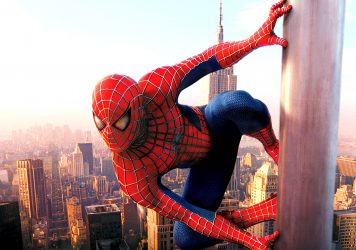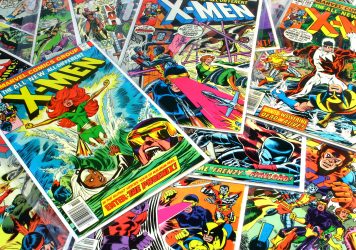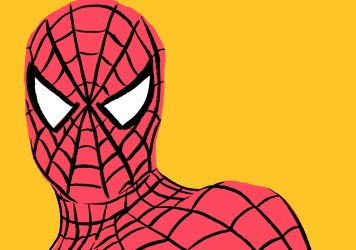
As Tom Hardy’s Eddie Brock tells everyone in Venom, he is a reporter. A crusading journalist holding big corporations to account. Someone so dedicated to telling the truth, he balks at the idea of broadcasting a puff piece on Charlton Drake (Riz Ahmed), a powerful businessman who is testing alien ‘symbiotes’ on San Francisco’s homeless population. Smelling a story, Brock breaks into Drake’s secret laboratory and accidentally merges with Venom, a symbiote with a noble bloodlust.
Ruben Fleischer’s film isn’t interested in offering a nuanced representation of journalism. Unlike The Post or Spotlight, Venom is neither a rousing endorsement of the First Amendment nor a realistic portrayal of what it really means to work for a major newspaper. Frankly, watching Brock send out follow-up emails and rewriting press releases wouldn’t exactly make for top blockbuster entertainment. Brock’s profession is simply window dressing, a superficial character trait that services the plot. It allows the screenwriters to believably establish tension between Brock and the film’s primary antagonist (Ahmed).
Venom’s version of journalism fits snuggly alongside the other portrayals in superhero movies. Much like in the rom-com – a genre whose depiction of journalism has led many an aspiring writer to believe they’ll soon be able to afford a penthouse apartment – the role of a superhero journalist is to give the writers a get-out-of-jail-free card when plotting an adventure. Similar to how Richard Gere’s job as a columnist in Runaway Bride creates a flimsy reason for him to meet Julia Roberts, the superhero journalist is often thrust into dangerous situations because this is what people have been conditioned to believe the job demand of them.
In 2016’s Batman v Superman: Dawn of Justice, Amy Adams’ Lois Lane interviews a terrorist only for it to go wrong just so she can be saved by Superman. During an interview with former Spider-Man Andrew Garfield, Adams indirectly summed up the role journalism plays in most superhero movies when she admitted she felt she was “in service of the story instead of the character”. Adams is racking up appearances as bad journalists, and while that is the point of her self-destructive character in HBO’s Sharp Objects, Lane is at least shown to be a good investigator in Man of Steel, tracking down someone who doesn’t want to be found and deducing that Clark Kent is Superman by speaking to a man at an IHOP.
Lane’s profession puts her in a variety of situations from which she invariably needs rescuing. In 1980’s Superman II, she chases some terrorists to the top of the Eiffel Tower only for Superman (Christopher Reeve) to fly in and save her. In Batman v Superman, her investigation causes Lex Luther (Jesse Eisenberg) to kidnap her and drop her from a building to be saved. In the 21st century, filmmakers have tended to balance out Lane’s need to be constantly rescued by giving her masculine traits. She shoots whiskey – a hallmark of every hard-boiled hack – and reinforces the idea that the journalists who report hard news must be exemplar’s of virility.
Marin Cogan describes female journalists in popular culture as “slutty ambition monsters”. In contrast to real life, female journalists can be found sleeping with their sources as far back as 1981’s Absence of Malice. Even Lane ends up having sex with Superman in a bathtub or, in Margot Kidder’s case, the Fortress of Solitude. The common depiction of journalists like Lane and Brock in a superhero movies is essentially an extension of the crusading gumshoe established in films like 1976’s All the President’s Men.
The worlds superheroes inhabit have roots in the pulpy noir stories and serials of 1930s. Superman’s creators, Jerry Siegel and Joe Shuster, were partly inspired by ‘The Front Page’, a play later adapted into the rapid-fire 1940 romantic comedy His Girl Friday. It’s no coincidence that Sam Raimi pays homage to classic Hollywood screwball comedies in his Spider-Man trilogy, yet he also makes some vital observations about the media industry via The Daily Bugle.
Cigar always in-hand, publisher J Jonah Jameson (JK Simmons) is profit driven, hiring Peter Parker (Tobey Maguire) because Spider-Man sells papers. The ethics of Peter publishing his selfies as news is a conundrum that’s never really dealt with, but we witness the arrogant vulgarity of turn-of-the-century journalism in Jameson’s smear campaign: “If we can get a picture of Julia Roberts in a thong, we can certainly get a picture of this weirdo,” and, “If he doesn’t want to be famous, then I’ll make him infamous!” There is little attempt at objectivity here.
But the pure comedic joy of watching Simmons interact with the rest of the newsroom dilutes the potency of the representation . That is, until 2007’s not-as-bad-as-you-remember Spider-Man 3. The final film in Raimi’s series contains arguably Jameson’s best moment, as he struggles to contain his rage when dealing with an entrepreneurial kid (“films extra”) and allows the director to finish a running gag with panache. He also publishes a retraction for the first time in “20 years” when it transpires that Eddie Brock (Topher Grace) has faked a photo.
In Spider-Man 3, journalism is no longer merely a backdrop but integral grist in the narrative. Brock is set up as Parker’s bitter foil, and his dismissal sets him on the course to becoming Venom. Jameson doesn’t hesitate to fire Brock, and Raimi shows us a side of journalism rarely seen on film – a newspaper that owns up to its mistakes.
Published 5 Oct 2018

By Henry Bevan
The director’s 2002 franchise opener is a tribute to this iconic city and the people who live in it.

As a kid, I found solace in the comic book characters who resembled my own outcast existence.

By Elena Lazic
Sam Raimi’s franchise midpoint is a perfect superhero sequel – a film with a sincere belief in humanity.